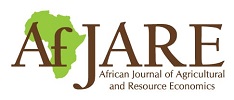All Articles
- All
- Special Issue
- Volume 13-1
- Volume 13-2
- Volume 13-3
- Volume 14-1
- Volume 14-2
- Volume 14-3
- Volume 14-4
- Volume 15-1 (March 2020)
- Volume 15-2 (June 2020)
- Volume 15-3 (September 2020)
- Volume 15-4 (December 2020)
- Volume 16-1 (March 2021)
- Volume 16-2 (June 2021)
- Volume 16-3 (September 2021)
- Volume 16-4 (December 2021)
- Volume 17-1 (March 2022)
- Volume 17-2 (June 2022)
- Volume 17-3 (September 2022)
- Volume 17-4 (December 2022)
- Volume 18-1
- Volume 18-2 (June 2023)
- Volume 18-3
- Volume 19-1
- Volume 19-2
- Volume 19-3
- Volume 19-4
- Volume 20-1
- Volume 8-1
- Volume 8-3
This paper investigates the interdependence of decisions on the adoption of agricultural technology and the simultaneous interaction between adoption and food security situations of smallholders, using a sample of 260 households from rural Ethiopia.
Poverty in its various forms is widespread among smallholder farmers, including income poverty, rendering interventions that improve household income relevant. We employ a linear model on cross-sectional data collected from October to December 2015, with the preceding 12 months as the reference period.
Building up resilience in agricultural households has assumed a critical role in development strategies in recent years because, it is argued, the costs of strengthening resilience are less than the recurring expenditure for disaster assistance.
The influence of food aid and remittances on West African food import demand is evaluated using a Central Bureau of Statistics (CBS) model. Our results show that imports of oilseeds and the rest of the agricultural products category are highly price elastic, and that fruit and vegetables and dairy products are least responsive to price changes.
Integrated pest management (IPM) has been promoted globally as an alternative approach to the widespread broad-spectrum chemical insecticidal application for the control of pests and diseases in agricultural production to minimise the harmful effects of the chemicals on humans and the environment.
L’Afrique Subsaharienne n'a pas assez bénéficié des grandes révolutions connues du monde agricole qui ont permis d’accroitre les productivités. Malgré l’existence des nouvelles technologies, les niveaux des productivités agricoles demeurent faibles et inférieurs à ceux d’autres régions en développement.
This paper contributes to the expanding literature on multidimensional poverty and gender inequality in Tunisia by presenting an individual measure of multidimensional poverty.
Low agricultural commercialisation due to low productivity and a lack of access to and use of improved seeds are common features of smallholders in the Ethiopian highlands. Seed-producer cooperatives (SPCs) were established and strengthened in these highlands to facilitate smallholders’ access to improved seed.
This study attempted to identify determinants of farmers’ maximum willingness to pay (WTP) for improved use of irrigation water.
Recognising potential selection bias due to non-randomness of the data, this study used propensity score matching on data from a nationally representative fifth Integrated Household Survey (IHS5) to investigate the effect of agriculture extension services on the technical efficiency of maize farmers in Malawi.
Vitamin A deficiency is still a challenge in many African countries, including Tanzania. Survey data were gathered in Tanzania to determine consumers’ risk perceptions of vitamin A deficiency (VAD) and severe visual impairment.
Climate change and heat stress are expected to worsen the issue of water scarcity that is affecting the agricultural sector, among others through increased crop prices and costs, in addition to changes in yields.
This paper investigates the extent of price volatility of maize and rice in Ghana following the introduction of public buffer stockholding operations (PBSO) as a policy to stabilise farm output prices in the last decade.
Our understanding of climate-induced crop failure and crop abandonment is limited at present. This study surveyed theoretical and empirical literature on climate-induced crop failure and crop abandonment.
The adverse effects of weather extremes produce widespread damage and cause severe alterations in the normal functioning of household agricultural production in Zambia. Extreme weather events such as floods and drought are expected to increase in intensity and frequency due to climate change.
African animal trypanosomiasis (AAT) and its vectors, mainly tsetse, are a major constraint to livestock production in sub-Saharan Africa (SSA). Control efforts have been ongoing for decades, but finding a sustainable solution remains a major concern.
This paper examines farmers’ preferences for an improved Bambara groundnut variety, the key attributes desired, factors influencing preference, and the number of attributes desired by smallholder farmers in Ghana.
This study examined the effect of collective marketing on mango income for 226 smallholder farmers in Mwala sub-county. The study employed an endogenous switching regression model to account for selection bias from observed and unobserved farmer attributes.
This article analyses the level of integration in pastoral markets in Kenya using high-frequency data generated through a crowdsourcing endeavour. The vector error-correction model framework was used to estimate the causal relationships between the short- and long-run market price.
Conservation agriculture is promoted as a green technology that enhances the productivity and food security of farmers. However, there is limited evidence from practising farmers regarding these expected outcomes.
The current study investigated the impact of using information and communication technology-based weather information services on the adoption of climate change adaptation strategies.
Empirical studies on the effects of governance structures on incentives have still received little attention in the wheat value chain research of developing countries. The purpose of this paper is to investigate the effects of governance structures on actors’ incentives in different functional nodes of the wheat value chain.
Recognising potential selection bias due to non-randomness of the data, this study used propensity score matching on data from a nationally representative fifth Integrated Household Survey (IHS5) to investigate the effect of agriculture extension services on the technical efficiency of maize farmers in Malawi.
This study evaluated the effect of agriculture, industry, manufacturing and the service sector on economic growth for the period 1991 to 2020 using the autoregressive distributed lag stationarity (ARDL) bounds-testing approach.
